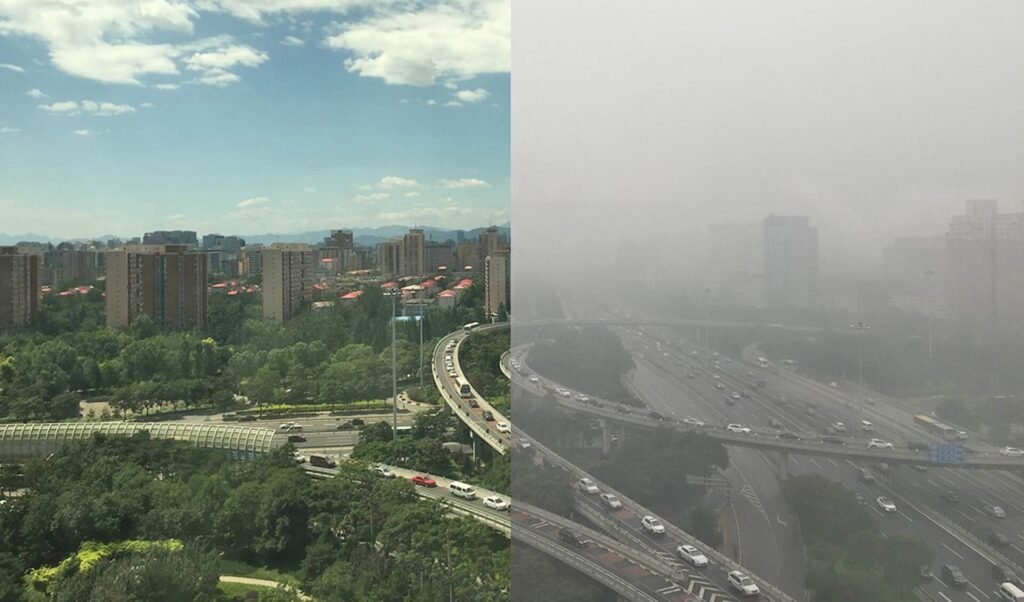Smog is one of those invisible dangers that we often don’t think about, but it’s everywhere—especially in big cities. It’s the reason we sometimes wake up to hazy, gray skies or struggle to breathe in certain areas. But while it might seem like just a nuisance or an occasional inconvenience, smog is actually a much bigger problem. It’s a silent threat, affecting our health, our environment, and even our climate in ways that most of us don’t realize.
1. What Exactly is Smog?
Smog is a mix of smoke, fog, and pollution. The term itself comes from combining “smoke” and “fog,” because that’s exactly what it looks like—a thick, dirty fog that reduces visibility and leaves the air feeling heavy. But it isn’t just a visual annoyance. It’s made up of harmful chemicals like ground-level ozone, sulfur dioxide, and nitrogen oxides, which can have serious consequences for our health and planet.
There are two main types of smog:
- Classical Smog (London-type): This is the old-school, industrial smog you might associate with places like 1950s London. It forms when sulfur dioxide (from burning coal) combines with moisture and particulate matter in the air. This type of smog is often the thick, suffocating kind that makes you feel like you’re breathing in a polluted fog.
- Photochemical Smog (Los Angeles-type): This is the kind of smog that forms in cities with a lot of cars and industrial activity. It happens when sunlight reacts with nitrogen oxides and volatile organic compounds (VOCs), which come from things like car exhaust and factory emissions. This type of smog creates a hazy, orange-brown color and is most common in places with a lot of sunshine and traffic.
2. How Does Smog Affect Our Health?
It might surprise you to know that it isn’t just something that makes the air smell bad. It’s a serious health risk.
- Breathing Problems: If you have asthma or any kind of respiratory condition, smog makes it harder to breathe. It irritates your lungs and can trigger attacks, making simple activities like going for a walk or playing outside difficult.
- Heart Issues: It doesn’t just affect your lungs—it can hurt your heart too. Long-term exposure of this has been linked to a higher risk of heart disease, strokes, and heart attacks. It can cause inflammation in your blood vessels and make them more likely to clog.
- Premature Death: Sadly, it is a leading cause of premature deaths worldwide. Studies suggest that the pollutants in it contribute to millions of early deaths every year, particularly among vulnerable groups like children, the elderly, and those with pre-existing health issues.
- Cancer Risk: Some of the chemicals in smog, like benzene and formaldehyde, are carcinogens. Over time, being exposed to them can increase your risk of developing lung cancer or other types of cancer.
3. How Does Smog Harm the Environment?
It’s not just people who suffer from this—nature feels its effects too.
- Damage to Plants and Crops:Particularly ozone, can stunt the growth of plants and crops, making them weaker and more susceptible to disease. This could threaten food supplies, especially in regions where crops like wheat, soybeans, and cotton are grown.
- Acid Rain: Smog can also contribute to acid rain, which harms forests, lakes, and rivers. Acid rain makes the soil too acidic for many plants to grow, harms fish in waterways, and even eats away at buildings and statues.
- Reduced Visibility: This reduces how far you can see, sometimes making it so bad that entire cities look like they’re shrouded in fog. This takes a toll on the beauty of landscapes and even affects the tourism industry in some places.
- Climate Change: Some of the pollutants that create smog, like black carbon (or soot), are also potent contributors to global warming. These particles trap heat in the atmosphere, making the planet warmer and changing weather patterns in the process.

4. Where Does Smog Come From?
Smog doesn’t come out of nowhere—it’s created by human activity. And sadly, the more we burn fossil fuels and pollute the air, the worse smog gets.
- Cars and Trucks: Most of it we breathe comes from vehicle emissions. Cars, buses, trucks, and motorcycles all release nitrogen oxides and volatile organic compounds, which are the main ingredients for photochemical smog.
- Industry: Factories, power plants, and refineries are major sources of the pollutants that create smog. They burn coal, oil, and gas, releasing sulfur dioxide and nitrogen oxides into the air.
- Agriculture: Farms can also contribute to it, especially through the use of fertilizers, pesticides, and livestock operations, which release ammonia and methane into the air.
- Wildfires: While wildfires might not always be caused by human activity, they create huge amounts of smoke and particulate matter that can exacerbate smog problems in nearby cities.
- Energy Production: Burning coal, oil, and gas to make electricity also releases these pollutants. Moving toward cleaner energy sources like wind, solar, and hydroelectric power is one way to help reduce smog.
5. Where is Smog a Problem?
While smog affects many places around the world, there are some regions where the problem is especially bad.
- Asia: Cities like Beijing and New Delhi are famous for their severe smog, caused by rapid industrialization, growing populations, and heavy reliance on coal for energy. It’s common for these cities to have days where the air quality is so poor that it’s dangerous to go outside.
- United States: While air quality has improved in some places, smog still plagues cities like Los Angeles, Houston, and New York. In places with heavy traffic and industrial activity, smog can be a persistent problem.
- Europe: Some European cities like Paris, London, and Rome also struggle with smog, especially during winter months when heating systems are in full swing.
6. What Can We Do About Smog?
The good news is that smog isn’t a problem we’re stuck with forever. There are plenty of ways we can fight back.
- Clean up Transportation: The biggest source of smog is car emissions, so switching to cleaner vehicles, like electric cars, can make a huge difference. Cities can also reduce traffic by investing in public transportation and encouraging walking or cycling.
- Reduce Industrial Emissions: Factories and power plants need to be held to stricter pollution standards. Moving to renewable energy sources, like wind and solar, is one of the most effective ways to reduce this and tackle climate change at the same time.
- Green Cities: Cities can plant more trees, create green spaces, and build infrastructure that reduces the need for cars. Better urban planning can help cut down on smog by making it easier for people to live without relying on vehicles.
- Educate and Act: Raising awareness about the dangers of this and encouraging people to use cleaner energy, drive less, and support policies to reduce emissions can help make a big difference. It’s also important to stay informed about air quality, especially if you live in a smog-prone area.
Conclusion:
Smog is a silent killer. It’s a serious threat to our health, our environment, and even our future. But if we take action—by cleaning up our air, reducing pollution, and pushing for better policies—we can reduce the impact of this and create a healthier world for ourselves and future generations. The fight against smog is one we can win, but only if we all work together to clear the air.
This version is more conversational and connects the scientific aspects of this with real-world impacts that resonate with people’s everyday lives. It aims to be informative while also encouraging readers to take action and understand that the problem is urgent—but solvable.




One Reply to ““Smog: The Silent Threat to Our Health and Environment””